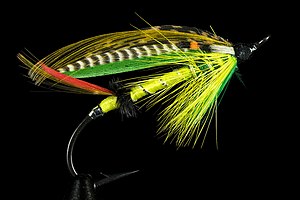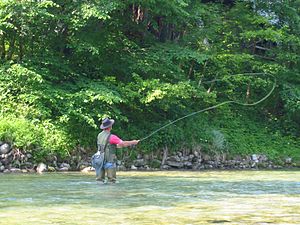 Image via WikipediaFly fishing is a unique fishing technique to catch fish by the use of artificial flies. This fun technique is used to catch different fish such as tarpon, pan fish, bass, trout, pike and salmon.
Image via WikipediaFly fishing is a unique fishing technique to catch fish by the use of artificial flies. This fun technique is used to catch different fish such as tarpon, pan fish, bass, trout, pike and salmon.The two categories of fly fishing flies are wet and dry. Wet fly fishing allows the artificial fly to go deep inside the water in order to attract the attention of the fish. Dry fly fishing allows the fly fishing lure to sit on the water and not get wet.
Fly fishing is the fastest growing fishing technique and this is due to the entertaining and relaxing nature of the sport. The basic fly fishing equipment is the rod, fly, and reel.
The artificial flies used are very lightweight and are made with fur, feathers and thread, using either artificial or natural material - attached to a small hook. The fly should be able to attract the fish by resembling one of the local insects.
Beginners need practice in order to get the fly to mimic the struggles of the insect in the water. This is what gets the attention of the fish. The fly resembles something in the diet of the fish and it typically looks like a bee, frog, grasshopper, moth, butterfly, wasp and the list goes on.
The fly rods are almost weightless and longer than regular rods; however, fly lines are larger and heavier than normal fishing line. The standard size of a flyrod is approximately 7 to 8 feet long for freshwater fishing. The heavy fly line is used to throw the fly toward the target. The man made fly rods are favored because they are cheaper and more versatile
For pan fishing you really need to master the roll cast I will have a video in an upcoming post. This is necessary to get the fly into some of the places pan fish live.
The most vital step in fly fishing is correctly executing the movement or landing of the fly on the water. This is important as it ensures that the fly has a natural look and the fish is paying attention to the bait without doubting its authenticity. The angler tries to throw the fly so it achieves perfect landing on the surface of water. (This seldom happens for me but the pan fish don't seem to care,)
When the fish bites with the fly, the fly line is then pulled by the angler and the rod tip is raised; this smoothes the process of the hooking the fish.
If you get the chance try this technique with a small foam ant, bee, wasp or a small bunny strip. Panfish love these things, especially under trees overhanging the pond or stream. If you can find or tie a weedless2 inch bunny strip you can catch crappie in lily pads and weeds. You have to have lots of bunny strips along because will catch bass also
Good Luck and Good Fishing
The Pan Fishing Maniac






